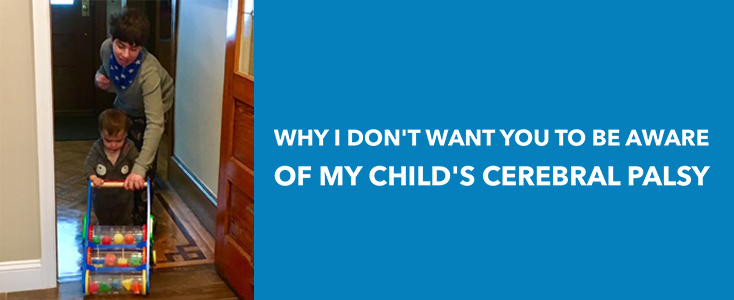Max helped his little brother lift a wheeled toy into the kitchen the other day. There’s a piece of wood at the entryway that Ben can’t navigate on his own, and I watched as Max lent him a hand. Seemingly, this is no big deal except Max has cerebral palsy and fine-motor skill challenges, and it took a fair amount of effort for him to grasp the wood handle and lift the toy up.
As usual, I was aware of his abilities and proud. Of course I am: I’m Max’s mom, the head of his cheerleading club and his faithful publicist. Sadly, though, many people out there are not aware of the abilities of people with cerebral palsy. Given that it’s Cerebral Palsy Awareness Month, I am here to make you…aware.
Until I had a child with CP, I wasn’t aware of the wide range of types it encompasses. Some people with CP move by walking; some use wheelchairs, walkers and other mobility devices. Some people with CP have minor weaknesses in one limb; some have weakness or spasticity in all of them. Some people with CP have cognitive impairment; some are as brilliant as they come.
Max has spastic four-quad CP. He walks, with support from leg braces. He has issues using his hands and with speech. He has intellectual disability, and while he’s plenty bright learning does not always come easily. In other words, like any human out there, he has his challenges—and like any human out there, he has his strengths and talents. To name a few: He’s got an amazing memory and sense of direction (Max is as trustworthy as our car’s navigator); he’s got a high emotional IQ (“Are you OK?” is one of his favorite phrases); and he’s amazingly personable and charming. Also: He’s got good hair.
People notice how cute he is. But otherwise, I’ve found that people who don’t know Max tend to only see the cerebral palsy instead of seeing the whole of who he is. They are acutely aware of his disability, and because that can make people uncomfortable, they aren’t sure what to say to him or how to act around him. “How old is he?” people ask as Max is standing right there next to me. Over the years, when I’ve told people that Max has cerebral palsy, the responses I’ve gotten have ranged from “Awwww” [head cocked to one side, looking sad] to “I’m sorry.”
“Oh, don’t be sorry,” I’ll chirp. “He is amazing.” And he is. (See: “Max’s head cheerleader and publicist.”)There is a real lack of awareness out there that children and adults with cerebral palsy are fully-formed children and adults who share the basic drives we all have: to connect with others, to explore, to learn, to have fun, to live a good life and to regularly eat their body weight in chocolate ice-cream. (Oh, wait, that’s just Max.) This awareness is impossible to achieve if people don’t get that a disability is just one part of who a person is—or, worse, they pity those who are disabled.
A few years ago, I spoke on a panel with blogger Katinka Neuhof, who writes at The Fabulous Adventures of a Four-Legged Woman. She told the story of rolling down a New York City street in a wheelchair, with her son by her side, when a passerby stopped and announced, “I’m going to pray for you.” I’ve heard similar stories from parents of children with CP. On occasion, strangers have approached me when I’ve been out with Max and said, “God bless you,” as if Max is a tragedy and I am a saint for being his mom.
True awareness about cerebral palsy starts with two key things: 1) People being aware of their misconceptions and preset ideas about what it means to have a disability; and 2) People viewing, approaching and treating those with CP as if they were any other people. Of course, accommodations may be necessary to level the playing field—but again, it all starts with the understanding and acceptance that children and adults with CP are not defective people but just plain old p-e-o-p-l-e.
Actually, come to think of it, I don’t want you to be aware of my child’s cerebral palsy. Maybe we should rename this Cerebral Palsy Non-Awareness Month?! Should you meet Max, I’d like you to talk directly to him, not to me. Ask him questions, not me. There’s no need to treat him with kid gloves or any elevated level of politeness.
Find out what his interests are, what his favorite school subjects are, what he’s interested in doing when he grows up. Joke around with him. Tease him, even. You know: Treat him like any teen, anywhere.
That would be true awareness.






